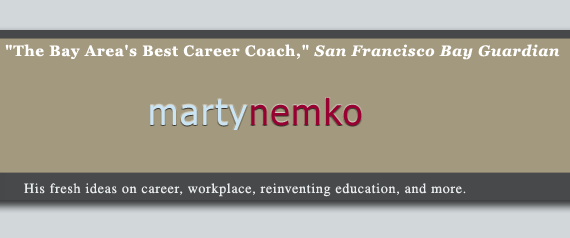Co-Coaching: "I'll Coach You if You'll Coach Me"
By Marty Nemko
My friend Miriam Weinstein first introduced me to co-coaching 30 years ago. Her car was (and probably still is) emblazoned with a “Question Authority” bumper sticker. So, it was no surprise that rather than pay some pipe-smoking Ph.D. big bucks to counsel her, she’d opt for, “I’ll coach you if you’ll coach me.”
Fact is, it worked well. So well that now, decades later, I still co-coach with a friend.
And when you think about it, it makes sense:
++ You and your friend, by definition, like each other, so there’s less risk of incompatibility than between a coach and a paying client.
++ Your friend has a head start over a professional because, when the first session starts, he already knows you very well.
++ Getting coached can feel disempowering, but if, half the time, you’re coaching another person, it evens out.
++ Because you know each other well,you both can insightfully suggest problems worth addressing.Of course, co-coaching is more effective when you have good coaching skills, so here’s a crash course. It omits components of co-counseling as officially defined, but I’ve found this streamlined version works well.
Of course, this won’t make you anywhere near as skilled as a professional, but combine the above advantages of co-coaching with the proven approach below, and you may find that you and your friend can get the help you need without having to pay a pro.
The following model works in many situations, career-related and otherwise:
In the first half hour, one person is the coach, the other is the client. In the second half hour, you switch roles.
1. Agree that everything said in the session is strictly confidential: “What goes on here, stays here.”
2. Say something like, “Tell me the problem you’d like to work on.”
3. "Would you like me to just listen, ask questions for clarification, or to get you to think more deeply about the problem, or make suggestions?"4. Listen carefully.
5. “What have you tried or considered already? Any other options you see?” Write all the options. If you’d like to add an option, ask, “Would you mind if I added one?”
6. “What do you see as the pros and cons of each?”
7. “So, what do you think you want to do?”
8. “Do you feel we’ve adequately addressed your problem for now?”
9. “Next week, would you like me to ask you whether your solution worked?” If so, write it down, so you remember to ask. Also, that makes the client feel accountable.
If the half hour isn’t up yet, ask, “Is there another problem you’d like to take a look at?”
At the half-hour mark, trade roles.
A variant on co-coaching is the “Success Team” in which three to six people meet weekly, and each member spends 15 minutes as “the client” while the others are the “coach.”
Of course, in some cases, you need a pro. Next week, I’ll show you how to find the right career counselor or coach for you.
© Marty Nemko 2004-2025. Usage Rights

